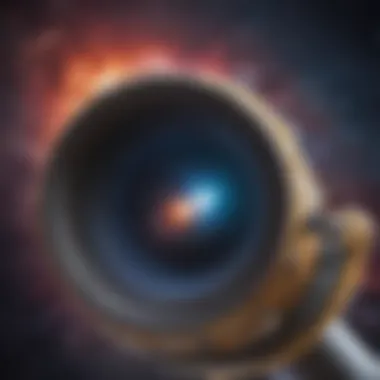Unveiling the Wonders of Astronomy Through Home Experiments


Science Fun Facts
Did you know that the largest volcano in the solar system is found on Mars? This giant called Olympus Mons stands about 13.6 miles high - nearly three times the height of Mount Everest!
Discover the Wonders of Science
Ladies and Gentlemen, get ready to embark on a thrilling journey through the cosmos from the comfort of your home. Witness the dance of the planets, peek into the hidden corners of our galaxy, and gaze upon the mesmerizing beauty of the stars.
Science Quiz Time
Time for a brain workout! Explore your knowledge of the universe with interactive quizzes and mind-bending puzzles. Challenge your friends and family to a space-themed trivia night, and let the cosmic fun begin!
Science Experiment Showcase
Gear up for some hands-on exploration! Gather your materials and follow detailed step-by-step instructions to conduct exciting astronomy experiments at home. From creating a model of the solar system to simulating lunar phases, prepare to be amazed by the wonders of the universe right in your own backyard.
Introduction to Astronomy
Understanding the Universe
A brief overview of astronomy
A brief overview of astronomy provides a foundational understanding of the celestial objects and phenomena that populate our universe. This section discusses the different components of the cosmos, including stars, planets, galaxies, and other celestial bodies. By exploring this overview, readers can grasp the sheer diversity and scale of the universe, setting the stage for deeper exploration in subsequent sections.
The importance of studying the cosmos
Studying the cosmos is crucial for expanding our knowledge and understanding of the universe. It allows us to unravel the mysteries of space, comprehend astronomical events, and appreciate the interconnectedness of celestial bodies. By delving into the importance of studying the cosmos, readers will realize the significance of astronomical research in broadening our perspectives and fostering a sense of curiosity and exploration.


Basic Astronomy Concepts
The solar system and its components
The solar system serves as our cosmic neighborhood, comprising the sun, planets, moons, asteroids, and comets. Understanding the structure and dynamics of the solar system is essential for comprehending our place in the universe. Through observing the motions of planets and their interactions, we can appreciate the gravitational forces that govern celestial bodies' movements.
Stars, galaxies, and nebulae
Stars, galaxies, and nebulae are the building blocks of the universe, forming intricate networks of cosmic structures. Exploring the characteristics and classifications of stars, galaxies, and nebulae enables us to discern different stellar evolutionary stages and cosmic formations. By studying these celestial entities, readers can grasp the vast scale and beauty of the universe, sparking curiosity and awe.
Setting Up Your Home Observatory
In the realm of understanding astronomy through home experiments, the pivotal step of setting up your home observatory offers an immersive experience into the celestial world. Establishing a dedicated space to observe the night sky not only enhances the quality of your astronomical endeavors but also brings you closer to the wonders of the cosmos. By taking the time to create a stargazing environment within your home, you open up a gateway to exploring the universe right from your backyard or balcony.
Choosing the Right Equipment
Telescopes and Binoculars
Delving into the realm of telescopes and binoculars is essential when crafting your home observatory for celestial observations. Telescopes, with their ability to magnify distant objects in the night sky, offer unparalleled views of celestial bodies such as stars, planets, and nebulae. On the other hand, binoculars, though less powerful than telescopes, provide a portable and user-friendly option for stargazing activities. The choice between telescopes and binoculars depends on factors such as viewing preferences and budget constraints.
Star Charts and Astronomy Apps
Navigating the vast expanse of the night sky becomes more accessible with the aid of star charts and astronomy apps. Incorporating these tools into your observational setup allows for seamless identification of constellations, planets, and other astronomical phenomena. While traditional star charts offer a hands-on approach to locating celestial objects, astronomy apps bring convenience and real-time tracking features to your stargazing sessions.
Creating a Stargazing Space
Designing a stargazing space in your home goes beyond merely setting up equipment; it involves considerations that enhance the overall stargazing experience.
Light Pollution Considerations


Mitigating light pollution is crucial for achieving optimal visibility during stargazing sessions. By selecting a location with minimal light pollution or implementing light-blocking measures, such as curtains or shields, you can improve the clarity of celestial observations. Minimizing light pollution ensures that you can enjoy a clearer view of the night sky and appreciate the beauty of cosmic phenomena.
Tips for Optimal Viewing Conditions
Optimizing your viewing conditions involves factors such as choosing the right viewing time, adjusting to the darkness for improved night vision, and aligning your equipment for an unobstructed view. Additionally, incorporating comfortable seating arrangements and maintaining a relaxed posture can enhance your stargazing experience. By following these tips, you create a conducive environment for exploring the night sky and unraveling the mysteries of the cosmos within the comfort of your home.
Astronomy Experiments at Home
In the realm of astronomy, conducting experiments at home serves as a crucial gateway to understanding the cosmos. The act of delving into astronomy experiments at home empowers enthusiasts to immerse themselves in the study of celestial bodies and unravel the mysteries of outer space firsthand. This hands-on experience not only fosters a deeper connection with the universe but also ignites a sense of curiosity and exploration. By engaging in astronomy experiments at home, individuals can observe cosmic phenomena up close, enhancing their knowledge and appreciation of the vast cosmos.
Observing the Night Sky
Identifying constellations
Embarking on the journey of identifying constellations is a pivotal aspect of exploring the night sky. This activity involves recognizing patterns formed by stars and understanding the mythological origins behind these celestial configurations. By mastering the skill of identifying constellations, astronomers can navigate the night sky with precision and uncover the stories woven into the stars. This practice not only enriches one's astronomical knowledge but also provides a sense of awe and wonder at the vastness of the universe.
Tracking the movement of planets
Tracking the movement of planets adds another layer of intrigue to stargazing sessions. By observing the way planets traverse the night sky over time, astronomers can grasp the dynamic nature of our solar system. Understanding planetary movements allows for the prediction of future celestial events and offers insights into the mechanics of our cosmic neighborhood. Despite the challenges posed by planetary motion, documenting and interpreting these movements can deepen one's appreciation for the intricate dance of celestial bodies.
Exploring Lunar Phases
Phases of the moon
Exploring the phases of the moon unveils the cyclic nature of Earth's natural satellite. By observing the moon's changing appearance throughout its cycle, astronomers can comprehend the interplay of light and shadow in space. This knowledge facilitates a better understanding of lunar patterns and their influence on various earthly phenomena, such as tides and cultural practices. Studying the phases of the moon serves as a foundational exercise in astronomical observation, laying the groundwork for further exploration of celestial bodies.
Creating a lunar calendar


Crafting a lunar calendar provides a practical way to track the moon's phases and incorporate them into daily life. By documenting the moon's progression through its phases, astronomers can anticipate lunar events and align activities with specific lunar stages. A lunar calendar not only aids in stargazing planning but also connects individuals to the rhythms of the cosmos. This hands-on approach to lunar observation enhances one's observational skills and fosters a deeper appreciation for the moon's ever-changing beauty.
Solar System Studies
Modeling planetary orbits
Delving into modeling planetary orbits allows astronomers to visualize the intricate paths traveled by planets around the sun. By creating simplified representations of planetary motions, enthusiasts can grasp fundamental concepts of orbital dynamics and planetary revolutions. Modeling planetary orbits aids in explaining celestial phenomena such as retrograde motion and conjunctions, offering a glimpse into the mechanics of our solar system. This hands-on activity fosters a deeper understanding of planetary dynamics and encourages further exploration of the cosmos.
Investigating the features of different planets
Investigating the unique characteristics of planets within our solar system provides valuable insights into the diversity of celestial bodies. By studying factors such as planetary composition, atmosphere, and surface features, astronomers can appreciate the distinct nature of each world. Comparing and contrasting planet traits not only enhances observational skills but also fosters a sense of wonder at the complexity of our celestial neighborhood. This activity sparks curiosity about the geological and atmospheric processes shaping planets, inviting further exploration and study.
Studying Stars and Galaxies
Learning to identify star types
Mastering the skill of identifying different star types aids astronomers in unraveling the tapestry of the night sky. By recognizing distinct characteristics such as brightness, color, and spectral class, enthusiasts can classify stars based on their unique attributes. Learning about different star types enhances observational skills and provides insights into stellar evolution and properties. This knowledge lays the foundation for exploring the vast array of stars dotting our galaxy, fostering a deeper appreciation for the beauty and diversity of the cosmos.
Exploring the concept of light years
Exploring the concept of light years introduces astronomers to the vast distances that define our universe. By understanding that light travels at a finite speed, enthusiasts can appreciate the immense scale of space and the implications of astronomical distances. Delving into light years allows individuals to contextualize the size and age of the universe, offering a perspective on the cosmic timeline. This exploration of astronomical measurement units deepens one's comprehension of space exploration and the boundaries of human knowledge, sparking awe and curiosity regarding the wonders of the cosmos.
Deepening Your Knowledge
In the realm of astronomy, the expansion of knowledge serves as a critical foundation. Deepening your understanding of celestial bodies and the mysteries of the universe not only cultivates a profound sense of wonder but also sharpens cognitive abilities. By delving into the vast expanse of astronomical knowledge, enthusiasts can enhance their analytical skills, critical thinking, and problem-solving capabilities. This section acts as a gateway to a deeper engagement with the cosmos, providing valuable insights and perspectives on the intricate workings of the universe.
Online Resources and Further Reading
Recommended websites for astronomy enthusiasts
Exploration of the cosmos is greatly enriched by top-notch online resources catering to astronomy enthusiasts. Websites such as Space.com, NASA's official site, and Sky & Telescope offer a treasure trove of information ranging from celestial events, astronomical discoveries, to tips for stargazing. Their user-friendly interfaces and comprehensive content make them essential companions in the journey of astronomical exploration. These websites stand out for their credibility, up-to-date data, and interactive features, ensuring a fulfilling and educational experience for readers.
Books to expand your understanding of the cosmos
Books play a pivotal role in expanding one's comprehension of the cosmos, offering in-depth exploration and detailed insights not easily found elsewhere. Titles like







